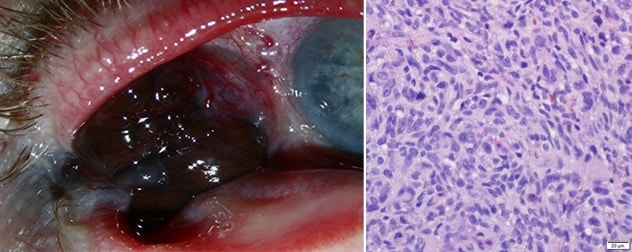Sept. 14, 2019
侵袭性结膜恶性黑色素瘤

侵袭性结膜恶性黑色素瘤
A. 内部脉管系统出现升高、色素沉着性球结膜病变的外部图片。B. 组织病理切片证实侵袭性结膜恶性黑色素瘤(苏木精-伊红染色剂,原始放大倍数 400)。
A variety of benign and malignant tumors occur in the conjunctiva. Some of them can be life-threatening: Conjunctival melanoma carries a 25% to 30% mortality rate. Population-based data on the incidence of these tumors provide important information for practicing physicians.
"Current population-based studies reviewing conjunctival melanoma, which originate mainly from Scandinavia, estimate the annual incidence to be between 0.06 and 0.52 cases per million. In other studies, the incidence of ocular surface squamous neoplasia (OSSN) has ranged from less than 0.1 cases per million in women in North America to 35 per million in Uganda," says Lauren A. Dalvin, M.D., ocular oncologist with Ophthalmology at Mayo Clinic in Rochester, Minnesota. "And although there have been several large series examining conjunctival lesions in the United States, the reports are primarily from tertiary care centers, making them subject to referral bias."
Using data from the Rochester Epidemiology Project, which captures more than 50 years of medical records from nearly all (148,201) residents of Olmsted County, Minnesota, Dr. Dalvin and a research team conducted a retrospective U.S. population-based study of conjunctival lesions. Results were published in the British Journal of Ophthalmology in 2018.
The research team searched the Rochester Epidemiology Project database to identify patients with conjunctival tumors in Olmsted County from Jan. 1, 1980, to Dec. 30, 2015, using unique codes from three sources:
- 25 Hospital International Classification of Diseases Adapted codes
- 24 International Classification of Diseases (ICD)-10 codes
- Eight ICD-9 codes
They then reviewed the records for demographics, types of tumors, histopathology, treatment and clinical course.
"Patients were only included if diagnoses were made or confirmed by an ophthalmologist or optometrist, and if they represented benign or malignant tumors," says Dr. Dalvin. "Because our initial search criteria were broad, we reviewed all cases to ensure all tumors were included while excluding degenerative lesions, conjunctivitis, cysts, phlyctenules, pingueculae, pterygia, granulomata and depositions.
"Lesions were then divided into benign and malignant. While benign melanocytic lesions, such as primary acquired melanosis, can transform into malignant melanoma, these lesions were classified as benign and followed for transformation into melanoma during the study period. Malignant tumors were categorized as melanocytic (malignant melanoma), premalignant and malignant epithelial OSSN, lymphoma or Langerhans cell histiocytosis."
More than 3,300 patients in Olmsted County were diagnosed with a conjunctival lesion in the study period. Medical record review confirmed the presence of a conjunctival lesion in 919 patients. Exclusions yielded 504 patients with conjunctival tumor.
Of those 504 patients, 248 (49%) were male; 383 (76%) were white, 50 (10%) were Asian, 30 (6%) were black, 39 (8%) were other races and for two (less than 1%) race was unknown. The age- and sex-adjusted incidence rate was 125 cases per million and the incidence increased over time. "We suspect the increasing incidence of all conjunctival tumors in our population was secondary to improved provider awareness and documentation of benign lesions as the study design relied on what was reported in the medical records," says Dr. Dalvin.
Of the total 504 patients, 474 (94%) had lesions that were benign. Melanocytic lesions accounted for the majority (431, or 86%), with adjusted incidence rates of 10.8 per million for complexion-associated melanosis, 49.7 per million for nevus and 44.1 per million for primary acquired melanosis.
Malignant lesions were rare (30, or 6%) with six cases of melanoma, 21 cases of OSSN, one case of Langerhans cell histiocytosis and two cases of lymphoma. The adjusted incidence rates of conjunctival melanoma and OSSN were 1.5 and 6.1 per million, respectively. Outcomes for melanoma and OSSN were favorable in 29 cases, with one death due to metastatic melanoma.
"Because the population of Olmsted County is predominantly white, results are most reasonably extrapolated to the semi-urban U.S. white population. In 2010, 72% of the total U.S. population was white, supporting this extrapolation. Population-based data from Olmsted County are similar to data from other U.S. communities," says Dr. Dalvin. "This study provides valuable epidemiological data that are directly applicable to general ophthalmologists encountering conjunctival tumors in a primary eye care setting. While most tumors are benign with low risk of malignant transformation, we recommend subspecialty referrals in the setting of changing appearance or worrisome features."
For more information
Mayo Clinic. Rochester Epidemiology Project.
Dalvin LA, et al. Population-based incidence of conjunctival tumours in Olmsted County, Minnesota. British Journal of Ophthalmology. 2018;102:1728.